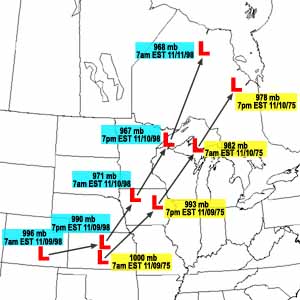 |
||||||
The Storm of November 9-10, 1975 The track of the November 1998 storm (labeled in blue) was very similar to the track of the November 1975 storm (labeled in yellow). Image created by Don Rolfson, National Weather Service Marquette The track of the November 1998 storm (labeled in blue) was very similar to the track of the November 1975 storm (labeled in yellow). Image created by Don Rolfson, National Weather Service Marquette
Track and measured pressure During the period of November 9-10, 1975, a strong autumn storm tracked from the central U.S. through the Great Lakes region. While intense, it was not unusually strong for November. Early on the morning of November 9, a low pressure system was organizing in central Kansas and had a pressure of 29.53 inches (1000mb). By the evening of November 9, the low had moved northeast to eastern Iowa and had strengthened to 29.32 inches (993mb). During the next 12 hours, the storm system underwent its most rapid intensification as it moved northeast into Upper Michigan. On the morning of November 10, the low was located over Marquette, MI, and had a pressure of 29.00 inches (982mb). The low tracked northeast across Lake Superior that morning before reaching just southwest of James Bay in Ontario during the evening. Its pressure that evening was 28.88 inches (978mb). Observations on Lake Superior Ship observations during the November 1975 storm showed sustained wind speeds of 30 to 45 knots from the northeast, east, or southeast prior to the low pressure system crossing the lake. As the low crossed the lake, winds shifted to the northwest and increased. Wind speeds of 50 knots were recorded over the eastern part of the lake. Ship observations indicated waves of 16 to 18 feet during the height of the storm. Keep in mind that the rare peak waves could have been one-and-a-half to two times that height. |
||||||
| Credits | Disclaimer | |
||||||